Conditions
Hip & Knee Pain

Hip Pain
Hip pain, one of the common symptoms that patients complain of, may not always be felt precisely over the hip joint. Pain may be felt in and around the hip joint and the cause for pain is multifactorial.

Knee Pain
Knee pain is a common condition affecting individuals from different age groups. It not only affects movement but also impacts the quality of life of the individual. An injury or disease of the knee joint or any structure surrounding the knee can result in knee pain.

Osteoarthritis
Osteoarthritis, also called degenerative joint disease, is the most common form of arthritis. It occurs most often in older people. This disease affects the tissue covering the ends of bones in a joint called cartilage. In a person with osteoarthritis, the cartilage becomes damaged and worn out causing pain, swelling, stiffness and restricted movement in the affected joint.

Sports Injuries
Sports injuries occur when playing indoor or outdoor sports or while exercising. They can result from accidents, inadequate training, improper use of protective devices, or insufficient stretching or warm-up exercises. The most common sports injuries are sprains and strains, fractures and dislocations.
Stress Fractures
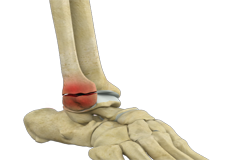
Stress Fracture of the Foot
A stress fracture is a small crack in a bone which occurs from an overuse injury. It commonly develops in the weight-bearing bones of the lower leg and foot. When the muscles of the foot are overworked, or stressed they are unable to absorb the stress and transfer it onto the bone, which cracks under the pressure.

Femoral Neck Stress Fracture
The Femoral neck is a part of the thigh bone (femur) which connects the head of the femur to the shaft of the femur. An injury or crack caused in the femoral neck due to repetitive force, overuse of the bone or insufficiency in bone development is termed a femoral neck stress fracture.

Back Injuries
Inhaled short and long-term control medications are used by inhaling measured amounts of the medication through inhalation devices.

Exercise is Medicine
At Perth Sports Medicine we are firm believers in the fact that ‘exercise is medicine’. We have known for a very long time now that exercise is very effective in preventing a wide range of medical conditions. There is now also an ever-increasing array of research that shows us that exercise is extremely effective at TREATING medical condition too.
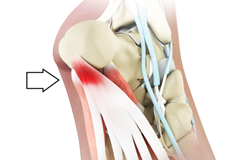
Plantar Fasciitis
Plantar fasciitis refers to inflammation of the plantar fascia, a thick band of tissue that is present at the bottom of the foot. It runs from the heel bone to the toe and forms the arch of your foot. Plantar fasciitis is one of the most common causes of heel pain.
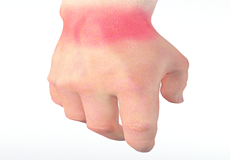
Strains & Sprains
Sprains and strains are injuries affecting the muscles and ligaments. A sprain is an injury or tear of one or more ligaments that commonly occurs at the wrist, knee, ankle or thumb. A strain is an injury or tear to the muscle. Strains occur commonly in the back and legs.

Tennis Elbow
Tennis elbow is the common name used for the elbow condition called lateral epicondylitis. It is an overuse injury that causes inflammation of the tendons that attach to the bony prominence on the outside of the elbow (lateral epicondyle). It is a painful condition occurring from repeated muscle contractions at the forearm that leads to inflammation and micro tears in the tendons that attach to the lateral epicondyle.
Bursitis
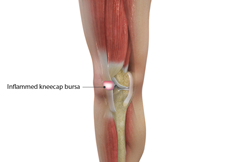
Knee Bursitis
A bursa is a small fluid-filled sac found between soft tissues and bones. It lubricates and acts as a cushion to decrease friction between bones when they move.
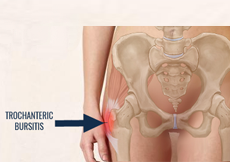
Hip Bursitis(Trochanteric Bursitis)
The hip bursa (trochanteric bursa) is a protective sac of fluid at the outside of the hip joint at the widest part of hips where the thigh bone protrudes close to the skin.
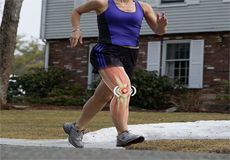
Runner’s Knee
Runner's knee, also called patellofemoral pain syndrome refers to pain under and around your kneecap. Runner’s knee includes a number of medical conditions such as anterior knee pain syndrome, patellofemoral malalignment, and chondromalacia patella that cause pain around the front of the knee.

Swimmer’s Shoulder Bursitis
The shoulder is a complex joint where several bones, muscles, and ligaments connect the upper extremity to the chest. The rotator cuff is a group of muscles and tendons that attach to the bones of the shoulder joint providing movement and stability to the shoulder. Inflammation of the rotator cuff tendons is called rotator cuff tendonitis or shoulder impingement and inflammation of the bursa that surrounds these tendons is called rotator cuff bursitis or shoulder bursitis.

Back Pain
Back pain or backache is the pain felt in the back that may originate from muscles, nerves, bones, joints or other structures in the spine. Back pain is one of the most common medical problems experienced by most people at some time in their life. It can be acute, usually lasting from a few days to a few weeks, or chronic pain, lasting for more than three months.
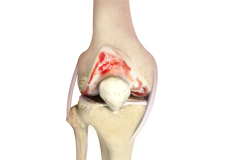
Arthritis
The term arthritis literally means inflammation of a joint, but is generally used to describe any condition in which there is damage to the cartilage. Inflammation is the body's natural response to injury. The warning signs that inflammation presents are redness, swelling, heat and pain.
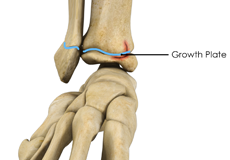
Growth Plate Injuries
Growth plates, also called the epiphyseal plate or physis, are the areas of growing cartilaginous tissue found at the ends of the long bones in children. These growth plates determine the length and shape of the mature bone. The growth plates are more susceptible to damage from trauma because they are not as hard as bones.
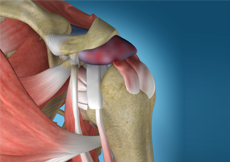
Shoulder Bursitis/Impingement
The shoulder is a very complicated joint that involves three bones that are all very mobile. There are numerous muscles involved: some muscles control the movements between those three bones so that the other, bigger muscles can produce powerful shoulder and arm actions.

Shoulder Instability and Dislocations
The shoulder is the most unstable and commonly dislocated joint that we have. There are many forms of instability and they all need to be treated differently.
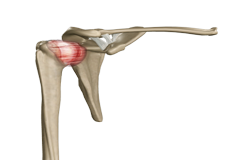
Frozen Shoulder
The shoulder is made up of three joints that all move together when the shoulder moves. Frozen shoulder occurs when the lining (capsule) of one of those joints becomes very tight and restrictive and that particular joint can become almost completely ‘frozen’.
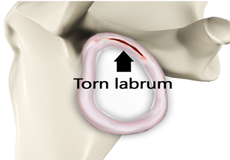
Shoulder Labrum Tear
The labrum (latin word for lip) is the cartilage that forms as a ‘lip’ around the shoulder socket that helps to make the socket deeper and more stable and helps the smooth movement of the shoulder joint. It can become torn in a variety of ways.

AC Joint Dislocation
An AC joint dislocation occurs due to heavy impact on the ‘point of the shoulder’. The most common causes are falls from bikes or skiing and heavy side-on impacts with opponents or the ground in contact/collision sports.
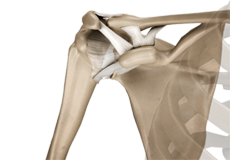
AC Joint Pain
An AC joint pain are first wrongly diagnosed as ‘impingement,’ ‘bursitis,’ ‘swimmers shoulder’ or ‘supraspinatus tendonitits’. This is a shame because AC joint pain is often usually very easy to treat. Often there will be pain lying on the effected side, reaching across or behind your body and performing pushing or lifting movements.
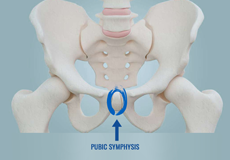
Osteitis Pubis
Osteitis Pubis is not actually one single condition but a collection of things that occur when there is instability or disruption of the pubic symphysis (pubic joint) or the muscles and tendons that attach to it.
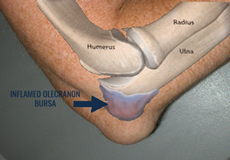
Elbow Bursitis
Bursitis refers to the inflammation and swelling of the bursa. Inflammation of the bursa on the point of the elbow is known as ‘olecranon bursitis’.
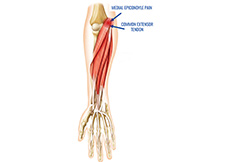
Golfer’s Elbow
Golfer’s Elbow occurs when that tendon gets overloaded, inflamed, strained or a combination of all three. Golfer’s Elbow commonly occurs due to unaccustomed, heavy or repetitive hand, wrist or forearm activities.
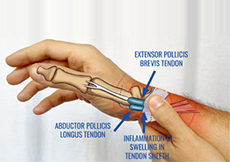
De Quervain’s Tenosynovitis
De Quervain’s Tenosynovitis refers to excessive inflammation in the lining of the tendons that pass through the wrist and into the thumb. Usually there is no damage to the tendon but there can be severe inflammation and pain in the sheath that surrounds it.
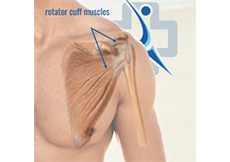
Rotator Cuff Tear
The rotator cuff is a term given to the four muscles that travel from the shoulder blade to the arm forming a ‘cuff’ around the shoulder joint. The rotator cuff is responsible for producing rotational and stabilising movements of the shoulder.

Biceps Tendon Subluxation
The biceps muscle travels from just above the shoulder joint to just below the elbow joint. Its upper attachment divides into two tendons: the ‘long head’ and the ‘short head’. The long head of biceps tendon travels deep into the shoulder joint and actually merges with the lining of the joint.
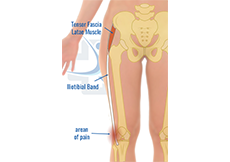
Iliotibial Band Friction Syndrome
The iliotibial band is a thick band of tissue that runs down the outside of the thigh. It starts above the hip joint and inserts just below the knee joint. This means that amount of tension in the ITB at any given time depends on the angle of both those joints as well as the pull of the muscles that attach to it (mainly the very strong gluteus maximus).

Tendon Injuries
Coming Soon

Muscle & Joint Pain
Coming Soon

Tendinopathies
Coming soon

Childhood Injuries
Coming soon

Buttock Pain
Coming soon
Others
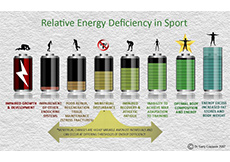
Relative Energy Deficiency in Sport (RED-S)
Relative Energy Deficiency in Sport (RED-S) is where the body is not taking in enough energy to meet the demands placed on it by the amount of exercise being performed. This is called Reduced Energy Availability.





















